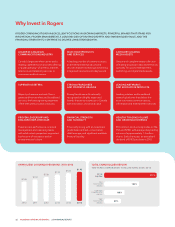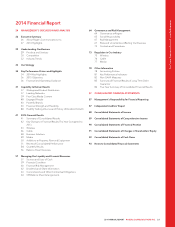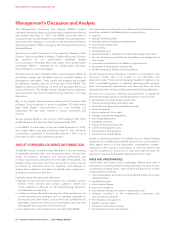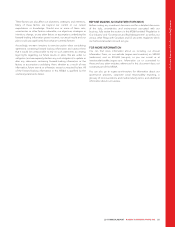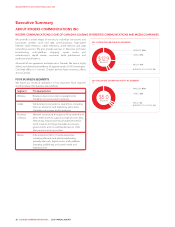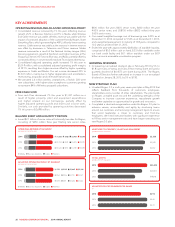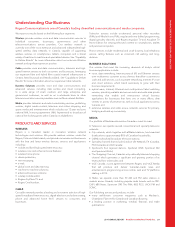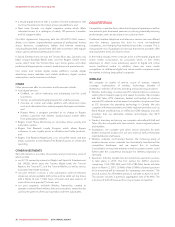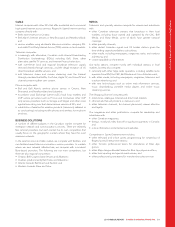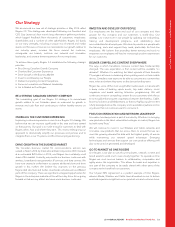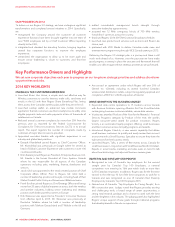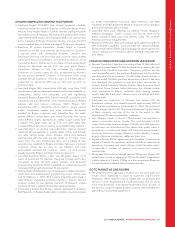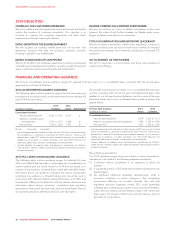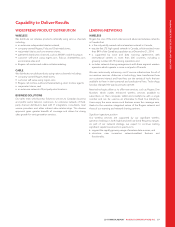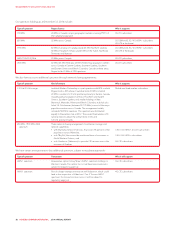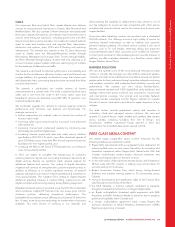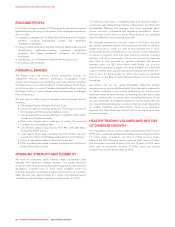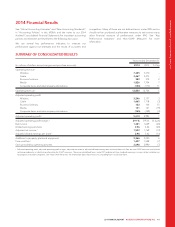Rogers 2014 Annual Report Download - page 36
Download and view the complete annual report
Please find page 36 of the 2014 Rogers annual report below. You can navigate through the pages in the report by either clicking on the pages listed below, or by using the keyword search tool below to find specific information within the annual report.
MANAGEMENT’S DISCUSSION AND ANALYSIS
INDUSTRY TRENDS
The telecommunications industry in Canada and our business segments are affected by several overarching trends.
CHANGING TECHNOLOGIES AND CONSUMER DEMANDS
Consumer demand for mobile devices, digital media and on-demand
content across platforms is pushing providers to build networks that
can provide more data, faster, cheaper and more easily. Increased
adoption of smartphones and double digit growth in our data revenue
continued this year, reflecting expanded use of applications, mobile
video, messaging and other wireless data.
ECONOMIC CONDITIONS
Our businesses are affected by general economic conditions and
consumer confidence and spending, especially in our Media segment,
where advertising revenue is directly affected by the strength of the
economy.
REGULATION
Most areas of our business are highly regulated, which affects who we
competewith,theprogrammingwecanoffer,whereandhowweuse
our networks, how we build our businesses and the spectrum we
purchase. The wireless and cable segments of the telecommunications
industry are both being affected by more regulation and more reviews
of the current regulations. See “Regulation in Our Industry”.
WIRELESS TRENDS CABLE TRENDS
More sophisticated wireless networks, devices and rise of
multimedia and Internet-based applications are making it easier and
faster to receive data, driving growth in wireless data services.
Wireless providers are investing in the next generation of
broadband wireless data networks, such as LTE, to support the
growing data demand.
Wireless market penetration in Canada is approximately 81.5% of
the population, and is expected to grow at an estimated 2%
annually.
The Canadian Radio-television and Telecommunications
Commission (CRTC) Wireless Code has limited wireless term
contractstotwoyearsfromthreeyears.
Subscribers are increasingly bringing their own devices and
therefore do not need to enter into term contracts for wireless
services.
The Internet and social media are increasingly being used as a
substitute for traditional wireline telephone services, and televised
content is increasingly available online, both on wireline and on
wireless devices. Cord-shaving and cord-cutting is on the rise with
the greater adoption of over-the-top (OTT) services, such as Apple
TV, Netflix and Android based TV boxes.
North American cable companies are improving their cable
networks and expanding their service offerings to include faster
broadband Internet. Our digital cable and VoIP telephony services
compete with continuing competitor IPTV deployments and non-
facilities based service providers, which continue to create pressures
that negatively impact growth.
RegulatoryrulingssuchastheCRTCLet’sTalkTVhearingcould
result in an increase in à la carte or “pick and pay” TV channel
options that may also impact industry growth.
BUSINESS SOLUTIONS TRENDS
MEDIA TRENDS
Companies are using fibre-based access and cloud computing to
capture and share information in more volume and detail. This,
combined with the rise of multimedia and Internet-based business
applications, is driving exponential growth in data demand.
Businesses are increasing usage and penetration of the Internet of
Things (IoT) to improve productivity and save costs.
Enterprises and all levels of government are dramatically
transforming data centre infrastructure and moving toward virtual
data storage and hosting. This is driving demand for more
advanced network functionality, robust, scalable services and
supportive dynamic network infrastructure.
In response, carriers are dismantling legacy networks and investing
in next generation platforms and data centres that converge voice,
data and video solutions onto a single distribution and access
platform.
Companies are increasing security for their data and information to
address cyber threats and other information security risks.
Consumer demand for digital media, mobile devices and on-
demand content is pushing advertisers to shift some of their
spending away from conventional TV to digital platforms.
Competition has changed as traditional media assets in Canada
become increasingly controlled by a small number of competitors
with significant scale and financial resources, while technology has
allowed new entrants and even individuals to become media
players in their own right. Across both traditional and emerging
platforms, many players have become more vertically integrated, as
both providers and purchasers of content creating more business
plan uncertainty as the relationship between these entities has
become more complex.
Finally, access to premium content has become even more
important for acquiring audiences that in turn attract advertisers and
subscribers. Ownership of content or long-term agreements with
content owners, therefore, have also become increasingly important
to media companies.
32 ROGERS COMMUNICATIONS INC. 2014 ANNUAL REPORT


